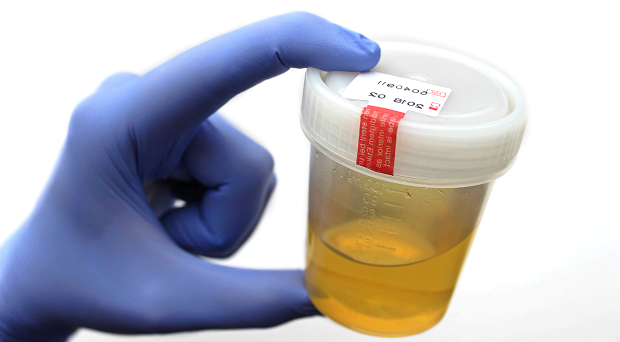This is a microscopic examination of the post-centrifugation urine sediment. Casts are enumerated at 10x (LPF). WBC, RBC, epithelial cells, crystals, and bacteria are enumerated at 40x (HPF). It can be very useful to make an air-dried (using a fan) urine sediment preparation and stain it with Diff-Quik to help identify cell types and bacteria. Wet-urine stains (e.g., Sedi-Stain™) are prone to forming precipitates that look exactly like cocci.
Red cells
- Increased numbers of red blood cells can be due to haemorrhage, inflammation, necrosis, trauma or neoplasia anywhere along the urinary tract or urogenital tract in voided specimens.
- Method of collection is important to know as catheterisation and cystocentesis can cause iatrogenic haemorrhage.
- Less than 5 RBC/hpf is considered acceptable for normal urine.
- Can lyse in dilute <1.008 or alkaline urine.
White cells
- Increased numbers of leucocytes is called pyuria and indicates an inflammatory process along the urinary tract or urogenital tract in voided samples. Causes include infection, uroliths or tumours.
- Less than 5 WBC/hpf is considered acceptable.
- Pyuria in the absence of bacteria may still be due to a UTI so culture may be indicated.
- Can lyse in dilute of <1.008 or alkaline urine.
Casts
- <2 hyaline or fine granular casts per 10x field is considered “normal”; 3 or more is considered abnormal
- All other kinds of casts are considered abnormal at any number
- Absence of casts does not rule out renal disease
- Casts degenerate with time and especially in alkaline urine
Squamous epithelial cells
- Generally represent contamination from genital tract or skin
- Frequently seen as contaminants in voided urine samples and in samples collected by catheterisation.
- If noted in high numbers in an intact male dog, causes concern for squamous metaplasia of the prostate. This is generally due to increased quantities of oestrogen which can be secreted by testicular tumours (particularly Sertoli cell tumours, occasionally interstitial tumours).
Transitional epithelial cells
- Originate from renal pelvis, ureters, urinary bladder, and urethra and naturally slough into the urine in low numbers so none to a few can be seen in the urine from healthy animals.
- Traumatic catheterisation of the bladder may result in increased numbers.
- In large numbers, especially in clusters, can be indicative of a transitional cell tumour.
- Examination of a stained, air dried sediment smear is indicated if atypical cells are seen and neoplasia is suspected.
Bacteria
- Bacteria can be insignificant contaminants or important pathogens.
- Differentiation between these two scenarios depends on clinical signs, method of collection, results of sediment examination etc.
- Bacteriuria in the absence of pyuria, can occur in animals that are immune-suppressed (Cushing’s, diabetes mellitus, FeLV, FIV etc.) or in patients with pyelonephritis.
- It can take 10,000 rods or 100,000 cocci/mL urine before they will reliably spin down into the sediment, so if none are observed it does not mean they are not presence, rather they are below the detectable limit.
- An air-dried and stained (Diff-Quik) preparation is recommended in cases where a UTI is suspected but bacteria are not apparent.
Crystals
- Crystals can be seen in the urine of healthy animals so the clinical significance of crystalluria should always be interpreted with clinical signs and other urinalysis data. Detection of crystals does not predict the presence of uroliths.
- Crystals can dissolve or form in vitro, particularly with time and temperature alterations.
- In patients with confirmed urolithiasis, the microscopic evaluation of the crystal composition should not be used as the sole criterion of the mineral composition of bladder stones or urethral plugs.
Crystals found more commonly in acidic urine (but not always):
- Bilirubin: bilirubinuria, cholestasis; in dogs is often of no clinical significance
- Calcium oxalate dihydrate: low numbers in health; suggests hypercalciuria +/- hyperoxaluria; if animal in acute renal failure, suggest ethylene glycol toxicity (antifreeze)
- Calcium oxalate monohydrate: rare in healthy animals; high numbers are associated with ethylene glycol toxicity
- Cysteine: rare; suggests liver dysfunction in breeds other than: Newfoundland, English Bulldog, Dachshund, Chihuahua, Mastiff, Australian Cattle Dog, Bullmastiff, American Staffordshire Terrier
- Drug crystals: Sulpha-containing drugs, contrast media, primidone
- Tyrosine: very rare; suggests liver disease
- Uric acid: seen in Dalmatians, English bull dogs; may suggest liver dysfunction and/or portosystemic shunt in other breeds of dogs and in cats
- Xanthine: rare; may reflect treatment with allopurinol
Crystals more commonly found in alkaline urine (but not always):
- Ammonium biurate: more common in Dalmatians and English Bulldogs; suggest liver dysfunction and portosystemic shunt in other breeds and in cats
- Calcium carbonate: normal in horses, rabbits, guinea pigs, and goats
- Calcium phosphate / amorphous phosphate: seen in healthy mammals; may be seen with calcium-phosphate uroliths
- Struvite (magnesium ammonium phosphate): often seen in the urine of clinically normal dogs, cats, and guinea pigs; cats with feline idiopathic cystitis; UTI with urease-positive bacteria promotes struvite crystalluria; uroliths of any composition

